- All
- Product Name
- Product Keyword
- Product Model
- Product Summary
- Product Description
- Multi Field Search
Please Choose Your Language
Views: 0 Author: Site Editor Publish Time: 2025-07-28 Origin: Site









Thinking about getting mulch for your garden project? In 2025, mulch prices will range from $15 to $160 per cubic yard. The price depends on the type, supplier, and delivery. Bulk natural mulch usually costs less. Specialty or rubber mulch costs more. Check out the price ranges below:
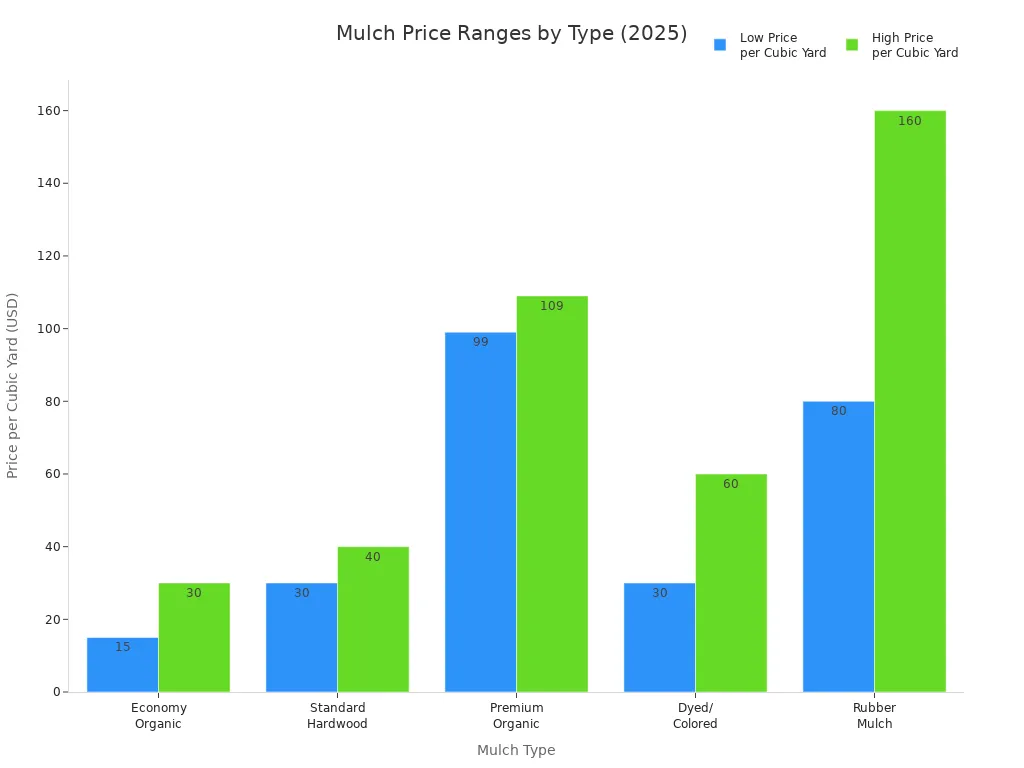
When you need to move mulch, use a strong metal wheelbarrow. Yongyi Metal makes tough wheelbarrows, hand trolly choices, and shelving racks. These tools help make gardening and landscaping easier.
Mulch prices are different in 2025. They can be as low as $15 or as high as $160 for each cubic yard. The price depends on the type and quality of mulch. - Buying mulch in bulk costs less money. It also helps cut down on plastic trash when compared to buying bags. - One cubic yard of mulch can cover about 108 to 162 square feet. The amount it covers depends on how thick you spread the mulch. - You can use this formula to find out how many cubic yards you need: (Length × Width × Depth ÷ 12) ÷ 27. - A strong metal wheelbarrow helps you move mulch more easily. It also makes moving heavy loads safer.
When you buy mulch by the yard, prices can be very different. The cost changes based on the mulch you pick. Organic mulch, like wood chips or bark, is usually cheaper. Inorganic mulch, like rubber or plastic, costs more. This is because it lasts longer and you do not need to replace it as often.
Here is a quick guide to mulch prices in 2025:
Mulch Type | Price Range per Cubic Yard (2025) |
|---|---|
Organic Mulch | $15 to $150 |
- Economy (wood chips, straw) | $15 to $30 |
- Hardwood | $30 to $40 |
- Specialty (cedar, cypress) | $99 to $109 |
Inorganic Mulch | $30 to $210 |
- Rubber Mulch | $80 to $160 |
- Plastic Mulch | Around $35 |
Tip: To save money, pick economy wood chips or straw. If you want mulch that lasts longer, rubber mulch might be worth the extra cost.
You can also see how the types compare in this chart:
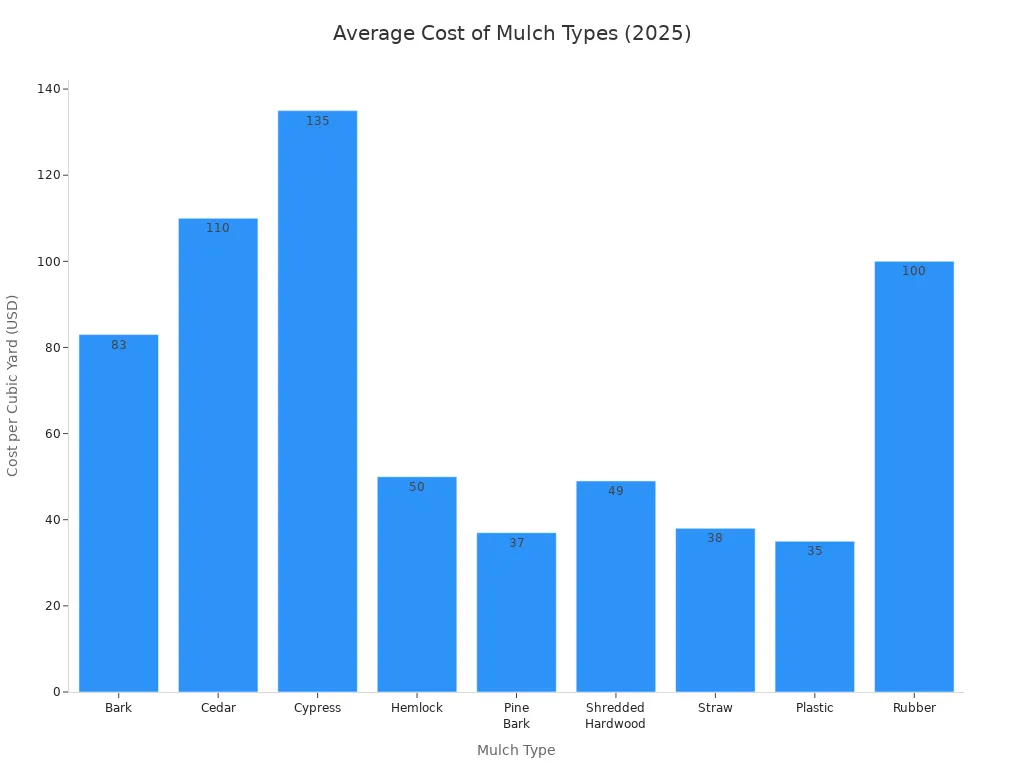
Many things can change the price you pay for mulch. Here are the main things to think about:
Material Source and Quality: Mulches like cedar or dyed mulch cost more. They last longer and look nicer.
Quantity: Buying a lot at once makes each yard cheaper. Small orders cost more because of extra fees.
Regional Availability: If you live close to a mulch supplier, delivery costs less. Cities often have higher prices.
Delivery Fees: Delivery can add $50 to $300 to your total. The price depends on how far and how much you order.
Bulk Discounts: Many sellers give 10% to 30% off if you buy a lot.
Seasonal Demand: Prices go up in spring and summer. You might find deals in fall and winter.
Extra Services: If you want edging, weed barrier, or mulch blowing, you will pay more.
Here is a table that shows how location changes mulch prices:
Location | Mulch Price Range (per cubic yard) | Notes on Regional Differences |
|---|---|---|
Chicago Area | $78 - $95 | Higher prices because of local supply and demand. |
Kenosha, Wisconsin | $45 - $60 | Lower prices because of local supply and demand. |
Note: Delivery and labor can be a big part of your total cost. Always ask for a full price before you buy.
You have a few choices when buying mulch by the yard. Each place has its own good points:
Local Garden Centers: These stores have many mulch types. You can see and touch the mulch before you buy. Workers can help you pick the best one.
Big Box Stores: Home improvement stores sell mulch in bulk and in bags. They might offer delivery or pickup.
Online Suppliers: Many companies let you order mulch online. This is good if you want to compare prices or need a lot.
Landscape Supply Yards: These places sell bulk mulch, soil, and stone. They often have the best prices for big orders and may deliver nearby.
Mulch Type | Description | Price per Cubic Yard | Purchase Options | Location Availability |
|---|---|---|---|---|
Black Bark Mulch | Organic, keeps its black color, adds nutrients, holds water, stops weeds | $36.00 | 1 Cubic Yard, Supersack options | Hendersonville location only |
Hardwood Brown Mulch | Protected by Color Shield, top grade brown, holds water, stops weeds | $33.00 | 1 Cubic Yard, Supersack options | Hendersonville location only |
Shredded Pine Bark Mulch | Best for stopping weeds, keeps color, holds water, liked by gardeners | $44.00 | 1 Cubic Yard, Supersack options | Hendersonville location only |
Pro Tip: To move mulch easily, use a strong metal wheelbarrow or a hand trolly from Yongyi Metal. These tools help you carry heavy mulch with less work. You can also use shelving racks to store your garden tools.
When you know the average price, what changes the cost, and where to buy, you can make a smart choice for your yard. Always compare prices, ask about delivery, and look for bulk deals to get the best price on mulch by the yard.
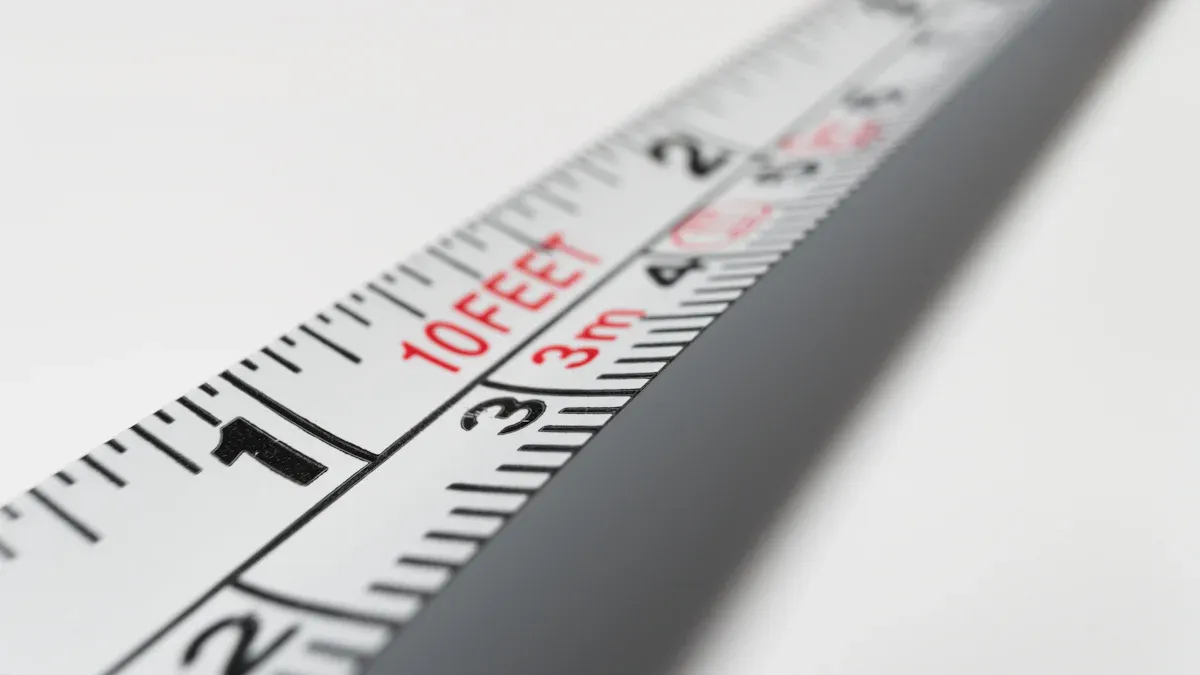
You might hear people talk about buying mulch by the "yard." But what does that really mean? A cubic yard is a unit of volume that equals 27 cubic feet. Here’s how you can picture it:
Measure out a space that is 3 feet long, 3 feet wide, and 3 feet high.
Multiply those numbers together: 3 × 3 × 3 = 27 cubic feet.
That’s one cubic yard of mulch.
Most mulch bags you see at the store hold 2 cubic feet. So, you would need about 13 or 14 bags to make up a full cubic yard. Buying by the yard often saves you money, especially for bigger projects.
Tip: When you order mulch in bulk, you get more for your money and reduce plastic waste from bags.
You want to know how far one cubic yard of mulch will go in your garden. The answer depends on how thick you spread it. Here’s a quick guide:
Depth (inches) | Coverage (square feet) |
|---|---|
2 | 162 |
3 | 108 |
If you spread mulch 2 inches deep, one yard covers about 162 square feet. At 3 inches deep, it covers about 108 square feet. Most gardeners use 2 to 3 inches to keep weeds down and hold moisture.
For flower beds, 2 inches is usually enough. For new beds or weed-prone spots, go with 3 inches.
Figuring out how much mulch you need is easy with a simple formula. Just follow these steps:
Measure the length and width of your area in feet.
Decide how deep you want the mulch (in inches).
Use this formula:
Total cubic yards = (Length × Width × (Depth ÷ 12)) ÷ 27
Example:
You have a 10 ft × 10 ft bed and want 3 inches of mulch.
Area = 10 × 10 = 100 sq ft
Depth = 3 inches
Volume = (100 × (3 ÷ 12)) ÷ 27 = 0.93 cubic yards
Round up to 1 cubic yard
Need help moving your mulch? Yongyi Metal’s metal wheelbarrows and yard carts make the job quick and easy. You can also organize your tools with sturdy shelving racks from Yongyi Metal.
Ready to start your project? Use these tips to get the right amount of mulch and the best tools for the job. For more details on wheelbarrows and garden carts, check out Yongyi Metal’s full product range.
When you start moving mulch, soil, or rocks, you want a tool that can handle the job. A metal wheelbarrow gives you the strength and durability you need for heavy-duty gardening and landscaping. You can count on it to last through tough projects and rough terrain.
Here’s why you might choose a metal wheelbarrow for your yard work:
You reduce physical strain and injury risk by making fewer trips and lifting less.
You move heavy or bulky materials like mulch, compost, and rocks with ease.
You save time by carrying plants, seedlings, and tools together.
You collect and dispose of garden debris, like leaves and twigs, more efficiently.
You lay mulch and compost evenly, thanks to easy transport.
You handle large quantities of soil for new beds or garden upgrades.
You pick the right type for your needs: single-wheel for tight turns, two-wheel for extra stability.
A metal wheelbarrow stands out for its toughness. Many gardeners report using steel wheelbarrows for years without problems, even when hauling loads over 500 pounds. With a little care, like keeping it dry and applying a protective finish, your metal wheelbarrow can last for decades. Plastic wheelbarrows are lighter and resist rust, but metal models often win for heavy-duty use and long-term value.
Tip: If you want a tool that can handle big jobs year after year, a metal wheelbarrow is a smart investment.
Not all wheelbarrows are the same. When you shop for a metal wheelbarrow, look for features that match your gardening style and the size of your projects.
Here are the most important things to consider:
Tray Size:
Small (2-3 cu ft): Good for light tasks or small gardens.
Medium (4-6 cu ft): Versatile for most gardening jobs.
Large (7-10 cu ft): Best for heavy-duty loads and big yards.
Wheel Type:
Single wheel: Easier to turn and maneuver in tight spaces.
Two wheels: More stable, especially on uneven ground.
Pneumatic tires: Air-filled, great for rough terrain.
Solid rubber tires: No flats, less maintenance.
Handle Design:
Ergonomic grips: Reduce hand fatigue.
Steel or wooden handles: Choose what feels best for you.
Height and shape: Look for a natural grip and comfortable posture.
Weight Capacity:
High capacity means you can haul more mulch or soil in one trip.
Heavy-duty steel construction supports big loads safely.
Other Features:
Powder-coated finish to prevent rust.
Reinforced welding for extra strength.
Easy assembly and simple maintenance.
Good balance and stability to prevent tipping.
Feature | What to Look For | Why It Matters |
|---|---|---|
Tray Size | 4-6 cu ft for most jobs | Fewer trips, less effort |
Wheel Type | Pneumatic or solid rubber, 1 or 2 wheels | Smooth ride, stability, easy turning |
Handles | Ergonomic, steel or wood | Comfort, control, less fatigue |
Weight Capacity | 300+ lbs for heavy-duty work | Safe, efficient hauling |
Finish | Powder-coated steel | Rust resistance, longer life |
Note: Always check the weight rating and tray size before you buy. The right metal wheelbarrow makes your work faster and easier.
Yongyi Metal leads the way in durable, reliable metal wheelbarrows for gardening and landscaping. With over 16 years of experience, Yongyi Metal offers a wide range of models designed for both home gardeners and professionals. Customers in Europe, South America, and Africa trust these wheelbarrows for their strength and long-lasting performance.
Here are some top choices for 2025:
Yongyi Metal Commercial Yard Cart
Large steel tray for hauling mulch, soil, or stones.
Heavy-duty frame supports big loads.
Ergonomic handles for comfort.
Price range: $139 to $183.
Yongyi Metal Single-Wheel Garden Wheelbarrow
Great for tight spaces and easy turning.
Sturdy steel construction.
Pneumatic tire for smooth movement.
Yongyi Metal Dual-Wheel Heavy-Duty Wheelbarrow
Extra stability for uneven ground.
High weight capacity for big projects.
Solid rubber tires for low maintenance.
You can also find related products like hand trolly and yard carts in the Yongyi Metal lineup. These tools help you move mulch, tools, and garden supplies with less effort. Each model comes with clear manuals and easy-to-follow guides, so you can get started right away.
Looking for a wheelbarrow that lasts? Choose a metal wheelbarrow from Yongyi Metal. You’ll get a tool that stands up to tough jobs and keeps your garden projects running smoothly.
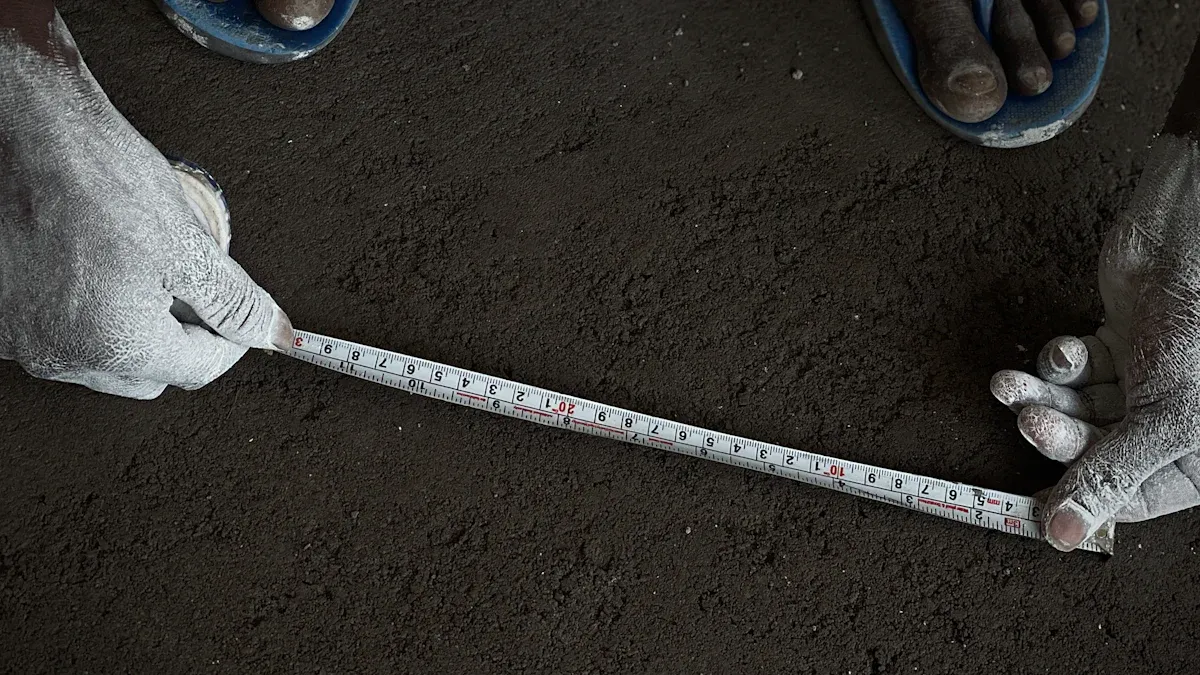
When you start moving mulch, you want to know how much your wheelbarrow can hold. Most wheelbarrows for gardening and landscaping come in sizes from 2 to 8 cubic feet. Smaller wheelbarrows work well for light garden tasks. Larger ones help you move more mulch at once, which saves time on big projects.
Here’s a quick look at common wheelbarrow sizes:
Capacity (cu ft) | Tray Material | Tire Type | Brand Example |
|---|---|---|---|
6 | Poly Tray | Pneumatic Tire | Yongyi Metal |
6 | Poly Tray | Flat-Free Tire | Yongyi Metal |
8 | Poly Tray | Flat-Free Tire | Yongyi Metal |
6 | Steel Tray | Pneumatic Tire | Yongyi Metal |
8 | Poly Tray | Pneumatic Tire | Yongyi Metal |
6 | Steel Tray | Flat-Free Tire | Yongyi Metal |
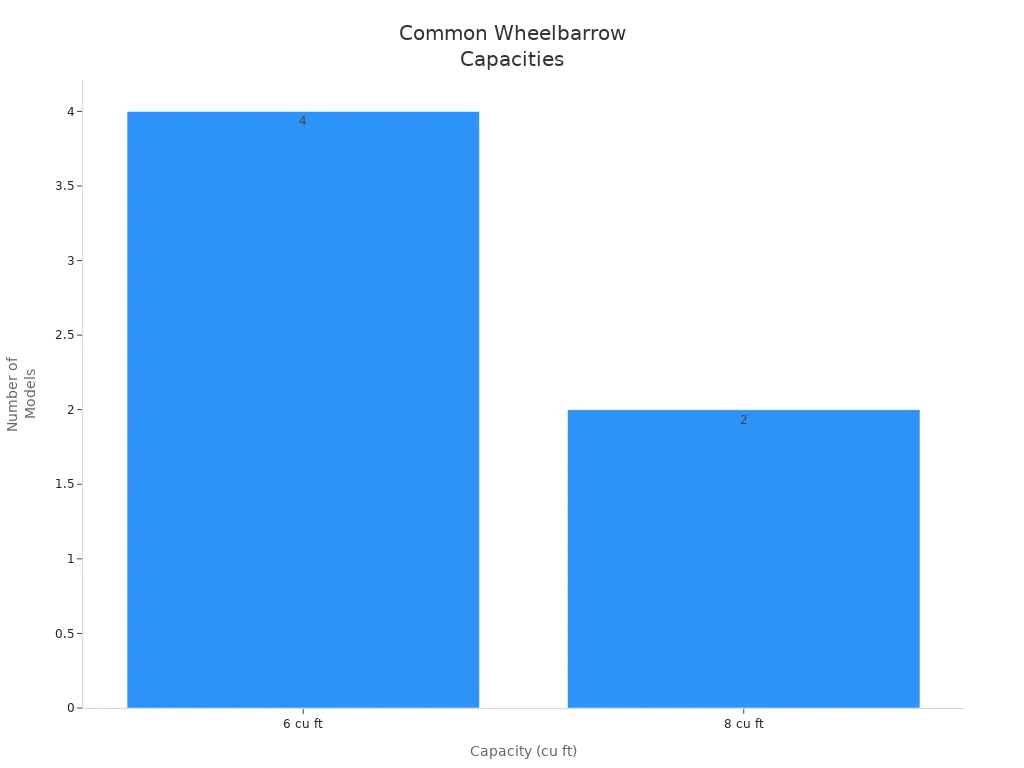
Most gardeners choose a 6 or 8 cubic foot wheelbarrow. These sizes give you a good balance between easy handling and carrying enough mulch. If you use a metal wheelbarrow, you get extra strength for heavy loads. For smaller jobs, a hand trolly can also help move bags or tools.
Now, let’s figure out how many trips you need to move a yard of mulch. One cubic yard equals 27 cubic feet. If your wheelbarrow holds 4 cubic feet, you’ll need about 7 trips to move a full yard. With a 6 cubic foot wheelbarrow, you only need about 4 to 5 trips.
Here’s a simple table to help you plan:
Wheelbarrow Size (cu ft) | Loads Needed for 1 Cubic Yard |
|---|---|
2 | 14 |
4 | 7 |
6 | 4.5 |
8 | 3.5 |
Tip: Use a larger wheelbarrow if you want to finish faster, but make sure you can handle the weight.
When you pick a wheelbarrow, think about the wheel design. Single-wheel models turn easily and work well in tight spaces. You can steer them around corners and over rough ground. Dual-wheel models give you more stability, especially with heavy mulch. They don’t tip as easily, but they need more room to turn.
Feature | Single-Wheel Wheelbarrow | Dual-Wheel Wheelbarrow |
|---|---|---|
Maneuverability | High, easy to steer | Lower, needs more space |
Stability | Needs balance, can tip | Very stable, less tipping |
Best Use | Tight spots, rough ground | Heavy loads, flat surfaces |
If you want to move mulch quickly and safely, choose the right size and wheel type for your yard. For big projects, a sturdy metal wheelbarrow from Yongyi Metal makes the job easier. You can also organize your garden tools with shelving racks for a tidy workspace.
You now know what to expect when buying mulch by the yard. Here’s a quick look at average prices:
Mulch Type | Price Range (per yard) |
|---|---|
Basic Mulch | $30–$50 |
Mid-Range Mulch | $50–$75 |
Premium Mulch | $75–$100+ |
When picking a metal wheelbarrow, focus on these tips:
Choose steel for strength and durability.
Match the tub size to your project.
Pick the right tire for your terrain.
Use these tips and Yongyi Metal’s full range of metal wheelbarrows, hand trolly, and shelving racks to make your gardening projects easier and more efficient.
You measure your garden bed’s length and width in feet. Decide on mulch depth (inches). Use this formula:
Cubic yards = (Length × Width × (Depth ÷ 12)) ÷ 27
Round up to the next yard for best coverage.
A metal wheelbarrow from Yongyi Metal works best. You can also use a hand trolly or a garden cart for lighter loads. These tools save time and reduce strain.
Yes, most suppliers charge for delivery. The fee depends on distance and order size. Always ask for a full quote before you buy. Some companies offer free delivery for large orders.
One cubic yard covers about 108 square feet at 3 inches deep or 162 square feet at 2 inches deep. Use a table for quick reference:
Depth (inches) | Area Covered (sq ft) |
|---|---|
2 | 162 |
3 | 108 |
Yes! Use shelving racks from Yongyi Metal to organize your tools and keep mulch bags dry. This setup keeps your workspace tidy and your supplies easy to reach.